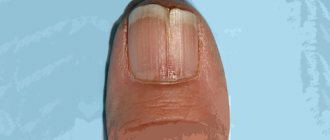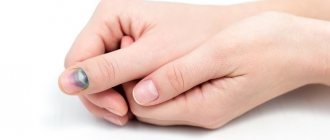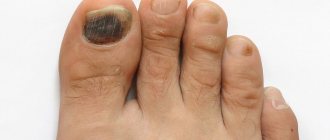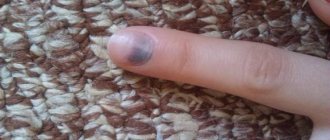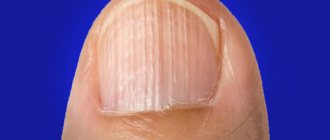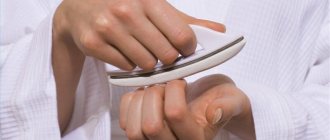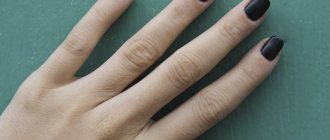Onycholysis is a condition in which the nail separates from the nail bed. In this case, there is no pain.
Usually this is not a one-time event; weakening occurs gradually - under the influence of a repeated or long-term factor.
Once the nail has moved away from the nail bed, it will no longer stick back. The effect of weakening the connection between the nail and the nail bed develops from the distal edge (tip of the nail) to its base (root of the nail). And, conversely, normalization of the situation is associated with the growth of a healthy nail from the nail fold to the distal edge. Most often, onycholysis is observed in women.
What is it called and why is it formed?
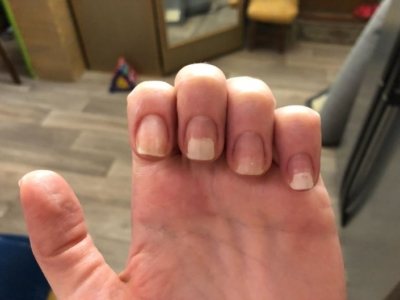
From a medical point of view, nail dystrophy occurs due to poor circulation. It becomes very thin and cannot function normally. The main task is to identify the disease at its initial stages. There may be several harmful factors that lead to this disease, but it is important to accurately determine the main one and remove it from a person’s life as soon as possible. Emptiness can form at any age, regardless of gender and lifestyle. There may be several reasons for the appearance of nail plates on the hands and feet:
- infectious;
- inflammatory;
- allergic.
Reasons for the appearance of onycholysis on the nail plates of the thumbs or other fingers and toes:
- Chemical or physical damage to the nail.
- Skin diseases: eczema, psoriasis, atopic dermatitis and others. As a rule, the patient's skin around the nail and cuticle becomes dry, thickened and flaky.
- As a result of taking antibiotics or other synthetic substances, a side effect may occur that causes white spots that progress quickly.
- Narrow, uncomfortable shoes cause the foot to be in a compressed state and also sweat a lot.
- Overactivity of the thyroid gland in some cases leads to the appearance of the disease.
- Separation of the nail plate can occur as a result of prolonged exposure to water.
- Excess body weight creates extra stress on the lower limbs, which leads to onycholysis.
- Chronic diseases of the digestive or endocrine system, blood vessels and heart.
- Fungal infections of the nail plate.
- Lack of beneficial vitamins in the body.
- Frequent stress and lack of microelements.
- Using nail polish removers containing acetone.
- Contact of chemicals on the fingers, causing the development of the disease.
- Poor quality hardware or hygienic manicure/pedicure.
- In rare cases, the disease is allergic in nature.
Such a defect cannot form suddenly. The disease gradually affects the nail plate, destroying it.
Attention! You can cover a sore nail with varnish, but this will not solve the problem. Even with minor voids under the nail, you should consult a doctor to identify the cause of onycholysis and its treatment. If you ignore the problem, there is a chance of completely losing the nail.
How to get rid of emptiness under the nail: reviews

If any defects appear on the nails, it is always unpleasant. Women especially worry very much, since their appearance and the way their hands look are important to them. Read reviews from other people who know how to get rid of hollow spots under their nails.
Natalia, 36 years old
Loceryl varnish helped me in the fight for my nails. I got infected in the pool. I stopped the growth of the fungus with varnish, but I couldn’t save the affected part and gradually sawed it off. Now I sometimes paint as a preventive measure, there have been no relapses yet. And there were nail crumbles, white dots inside, waves.
Ekaterina, 42 years old
When I was a student, I bought fashionable shoes one size smaller. I wore it for a long time until my legs began to hurt. The nails on my thumbs turned black, then a void formed. Now they grow back healthy, then again with holes. As soon as I start doing baths, applying creams - everything is fine, you forget a little - and it’s back to old times.
Olga, 23 years old
I got a hardware pedicure in an unfamiliar salon. It was urgent, and my manicurist was on vacation. The girl got under her nail a lot. After this procedure, a void formed at the angle of the nail and almost 1/3 inward. During the consultation, the dermatologist suggested that after the bath, carefully cut off the steamed nail with nail scissors, where there is emptiness. And drip Exoderil into the hole, several times a day. The treatment helped, and now I feel better.
Diagnostics
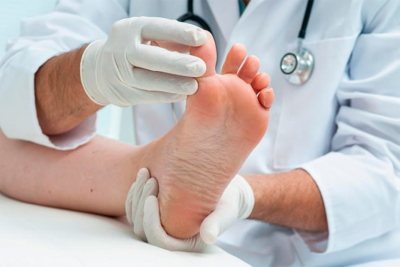
It is detected by physical examination of the affected nail plates. To select the correct treatment regimen, additional research is required to identify the cause of the disease and assess the general condition of the body. Laboratory diagnostics includes:
- Scraping from an area affected by fungi and bacteria. This analysis allows you to determine the type of pathogen and determine its sensitivity to certain drugs.
- A general blood test is performed to assess the condition of the entire body.
It is also recommended to consult a gastroenterologist, endocrinologist and other specialized specialists.
Treatment of onycholysis on the nail plates of the hands and feet
A doctor can determine the cause of the empty fragments inside under the toenail or fingernail. He is also the one who prescribes the correct treatment. To achieve the best result and complete recovery, therapy must be comprehensive.
Medications are prescribed orally to eliminate the underlying cause and keep the body in optimal condition during treatment. This method is important, because spores can enter the bloodstream, and the disease will worsen the person’s general condition.
- If white spots appear as a result of taking antibiotics, then bowel cleansing is required. In this case, the doctor will prescribe a drug for dysbiosis.
- Another cause of onycholysis is traumatic impact on the nail. This is the mildest form, which does not affect the body and is easy to treat. You can cure the nail plate using ointments for external use.
If the nail peeling is significant, it is strongly recommended to trim it as much as possible. In some cases, it is more rational to perform an operation to remove the entire nail plate so that it is easier for a new one to grow.
How to treat with medications?
Drug treatment includes the use of:
- medicines for treating nails;
- systemic drugs.

- To eliminate inflammatory processes, it is recommended to use: “Levomekol”, “Solcoseryl” and Vishnevsky ointment. They trigger the process of regeneration of damaged cells and promote rapid healing.
- Antimycotic drugs are required if onycholysis is accompanied by a fungal infection. Medicines can be medicated varnishes, ointments for treating nails and special solutions. These include: “Mikospor”, “Batrafen”, “Loceryl” and others.
Nail plates should be treated regularly, for the time prescribed by the doctor.
If the disease occurs due to poor nutrition, then you should balance your diet.
Important! A deficiency of multivitamin and mineral complexes often leads to the development of onycholysis.
Folk remedies
To achieve better results in less time, it is recommended to use traditional medicine.
Under no circumstances should you replace the treatment regimen prescribed by your doctor with folk remedies. They act as assistants and relieve unpleasant symptoms, but do not cure the disease itself.
Recommendations for the treatment of onycholysis using traditional methods:
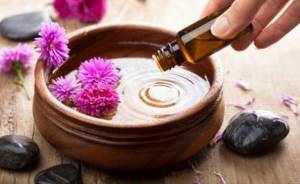
- Warm baths with the addition of tea tree essential oil and salt are an excellent remedy. Tea tree oil can be applied to the affected nail and rubbed in. Oils can also be dropped directly under the nail plate.
- Kombucha is an effective remedy. A small piece should be peeled off the film and crushed to a paste. Apply the resulting mixture to the affected area at least twice a day.
- You should rub olive oil into your nails at night, wear cotton gloves, and wash off in the morning.
- It is recommended to make baths with herbal decoctions: string, calendula, chamomile, St. John's wort and flax seeds.
- You can use a product that you can easily make yourself: squeeze the juice of one orange, add a spoonful of salt, 50 ml of plain or mineral water and 4 drops of iodine. The resulting mass should be mixed and your fingers should be kept in this mixture for at least 15 minutes.
- Compresses made from a mixture of alum, glycerin and water perfectly complement the main treatment. They are applied to a clean cotton swab and left on the affected area until completely absorbed.
- A gelatin bath promotes complete restoration of the nail. A little product is diluted in warm water and then fingers are immersed in the container for 10–15 minutes.
- Golden mustache juice will help strengthen and treat the nail. It accelerates growth and recovery.
- Garlic juice mixed with butter accelerates nail growth.
- Vinegar and soda baths restore the natural strength of the nail plate.
- Lemon juice has a beneficial effect on nail growth.
- During treatment, it is recommended to follow a special diet rich in calcium, potassium, fiber and protein.
For a complete recovery, strict compliance with all the doctor’s requirements in combination with traditional methods is required for several months.
Types of pathogens of onycholysis
During the acute period of the disease, a person will become infectious to other people. Therefore, the patient must refuse to visit a public bath, sauna or swimming pool. At home, he should have personal slippers and wardrobe items, which are changed daily and carefully ironed before putting on.
The main sources of the disease are:
- dermatophytes;
- yeast fungi (candida);
- epidermophytons;
- rubrophytosis;
- mycospores.
A pathological process can be suspected based on the following signs:
- change in nail color to gray or yellowish;
- itching, burning of the skin;
- a void has formed under the nail plate;
- in advanced cases, purulent discharge and deterioration of the body's condition may appear.

The disease occurs simultaneously with mycosis of the feet, in which the skin of the feet becomes hyperemic and dry. There is a change in gait, lameness, bleeding in the interdigital spaces.
What to do for prevention?
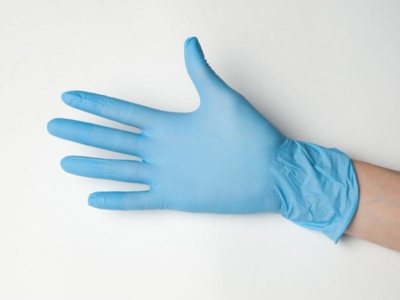
- Adhere to a complete, balanced diet: vitamins, minerals and other beneficial components must be present in your daily diet.
- It is important to change your attitude to the way you do household chores at least for the duration of treatment: protect your hands from direct contact with chemicals using rubber gloves.
- Minimize the risk of traumatic nail damage.
- For manicure and pedicure of nail plates, individual and disposable tools should be used. You need to cover the nail with high-quality varnishes, and remove it only with acetone-free liquid.
- Buy shoes that fit properly and are made only from quality materials.
- Physiotherapeutic procedures and finger massage will improve blood circulation and significantly reduce the risk of onycholysis.
Following these simple recommendations will help protect your nail plates from aggressive environmental influences.
Onycholysis is a serious disease that should never be left without treatment, otherwise there is a possibility of losing the nail or complications that will bring even more problems.
Treatment should be started in a timely manner, at the earliest stages, and then the recovery process will be quick and painless.
To avoid this disease in the future, you need to monitor the condition of your nails, protect yourself from contact with chemicals and maintain daily hygiene.
Diseases that can be identified by nails
First you need to understand what healthy human nails look like. These are matte plates that are slightly shiny and smooth to the touch. The bed should be visible through them. Also, the surface must be intact and durable. In addition, the connection with the side bolsters and the stock will be assessed.

If the bed is blue in color, then the problem lies in the heart or lungs. A diseased heart or poor circulation can instantly give a blue tint to the plates. If the plates are white and flat, the reason lies in anemia. This can be corrected with vitamins and iron. White tips - kidneys are sick. Milky coloration means liver cirrhosis is progressing. Discolored nails – allergies and stress.
Onychorrhexis is a disease in which the ends become brittle. This is also a signal that something is wrong with your body. There can be many reasons, including ailments such as lichen, psoriasis, baldness or eczema. It is necessary to contact specialists so that they can understand what is wrong and how to treat the reason that makes the nails look like this.
